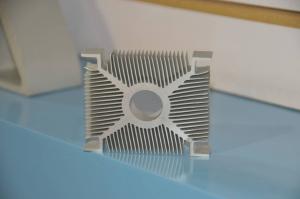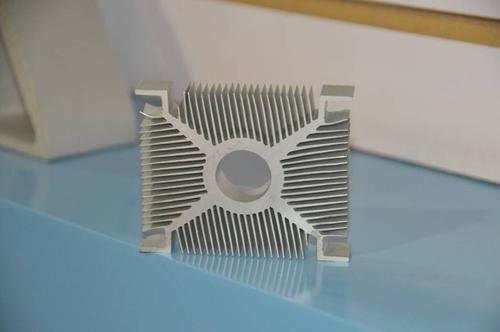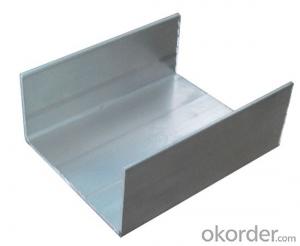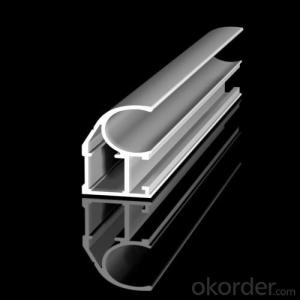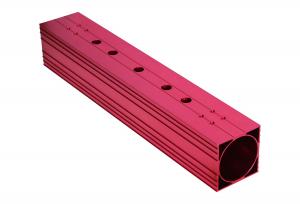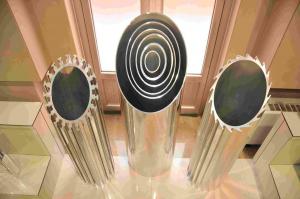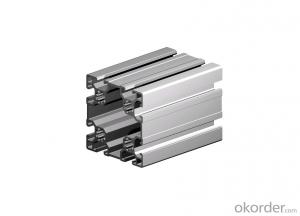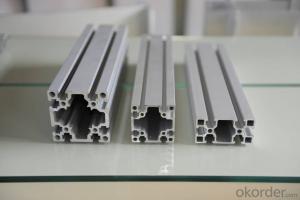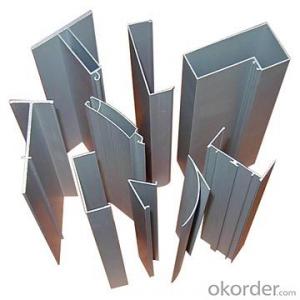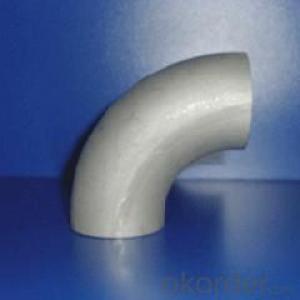Aluminum Corner Extrusion Profiles for Industrial Field Equipment Chilling
- Loading Port:
- China Main Port
- Payment Terms:
- TT OR LC
- Min Order Qty:
- -
- Supply Capability:
- -
OKorder Service Pledge
Quality Product, Order Online Tracking, Timely Delivery
OKorder Financial Service
Credit Rating, Credit Services, Credit Purchasing
You Might Also Like
Aluminum extrusion radiator profile for industry field equipment chilling
1. Usage: Industrial radiator
2. Surface:Anodizing, Powder coating, Electrophoresis
3. Alloy:6063
4. Size:according to customer’s requirement
5. Advantage:Durability, good corrosion resistance and lightweight
6. Package:Normal paper package and soft plastic interleaving each profile to protect the surface. In case of any special package, additional packing cost will be charged.
- Q: This question asks about the various dimensions and forms of aluminum profiles that are typically utilized in the construction of building frames.
- <p>Aluminum profiles used in building frames come in a variety of sizes and shapes to meet different structural requirements. Common profiles include rectangular tubes, square tubes, angles (L-profiles), channels, and tees. Sizes range from small (e.g., 10x10mm to 30x30mm) to large (e.g., 100x100mm to 200x200mm), with thicknesses varying from 1mm to 6mm or more. Shapes are tailored to specific applications; for example, I-beams and H-beams are used for their high strength-to-weight ratio. These profiles are chosen based on load-bearing needs, aesthetic preferences, and construction techniques.</p>
- Q: Are aluminum profiles suitable for greenhouse structures?
- Indeed, greenhouse structures find aluminum profiles to be well-suited. Given its durability, lightweight properties, and resistance to corrosion, aluminum has become a favored material for constructing greenhouse frames. The use of aluminum profiles ensures robustness and steadiness, enabling the creation of resilient greenhouse structures capable of enduring diverse weather conditions. Moreover, aluminum proves to be easily malleable and readily adaptable to meet specific design needs. Furthermore, its low-maintenance nature necessitates only minimal upkeep over time. All in all, aluminum profiles present themselves as a dependable and pragmatic option for greenhouse structures.
- Q: What are the different types of hinges used with aluminum profiles?
- Aluminum profiles offer various options for hinges, each serving a specific purpose. Here are a few examples: 1. Butt hinges, the simplest type, consist of two plates connected by a pin. They facilitate smooth opening and closing of doors or panels. 2. For larger or heavier doors, piano hinges are ideal. These lengthy, narrow hinges run the entire length of the door, providing additional support and stability. 3. Concealed hinges, as the name implies, remain unseen when the door or panel is shut. They are perfect for achieving a seamless appearance, commonly used in cabinet doors. 4. Pivot hinges enable doors or panels to pivot on a single point. They are suitable for taller doors or those needing to swing in both directions. 5. European hinges, also known as cup hinges or hidden hinges, are adjustable and ensure a smooth opening and closing motion. These are commonly found in cabinet doors. 6. In high-traffic areas or where door closure is crucial, self-closing hinges are equipped with a spring mechanism that automatically closes the door or panel after opening. These examples demonstrate the variety of hinges available for aluminum profiles. The choice of hinge depends on factors such as the application, size and weight of the door or panel, desired aesthetics, and functional requirements.
- Q: How do you select the appropriate aluminum profile for a specific application?
- Selecting the appropriate aluminum profile for a specific application involves considering several key factors. Firstly, it is important to understand the requirements and specifications of the application. This includes considering factors such as the load-bearing capacity, structural integrity, and overall functionality needed for the application. Next, it is crucial to evaluate the characteristics of the available aluminum profiles. This involves considering factors such as the alloy composition, strength, hardness, and corrosion resistance. Each application may require specific properties to ensure optimal performance and durability. Additionally, it is important to assess the dimensions and shape of the aluminum profile. This involves considering factors such as the length, width, and thickness required for the application. The shape of the profile, whether it is square, rectangular, or custom-designed, should also be taken into account. Another aspect to consider is the surface finish of the aluminum profile. Depending on the specific application, the surface may need to be smooth, textured, or treated to enhance its appearance or provide additional protection against wear, abrasion, or corrosion. Furthermore, it is essential to consider the availability and cost of the chosen aluminum profile. Evaluating the availability of the required profiles from different suppliers and assessing their cost-effectiveness is crucial to ensure that the chosen profile aligns with the budget and project timeline. Lastly, seeking expert advice and consulting with professionals who have experience in aluminum profiles for specific applications can be beneficial. They can provide valuable insights and recommendations based on their knowledge and expertise. In conclusion, selecting the appropriate aluminum profile for a specific application involves considering factors such as the application's requirements, the characteristics of the aluminum profile, dimensions and shape, surface finish, availability, cost, and seeking expert advice. By carefully considering these factors, one can choose the most suitable aluminum profile that will meet the requirements of the application effectively.
- Q: Can aluminum profiles be used for exhibition booths?
- Yes, aluminum profiles can be commonly used for exhibition booths. Aluminum profiles are lightweight, durable, and easy to assemble, making them an ideal choice for constructing exhibition booths. Additionally, aluminum profiles offer flexibility in design and can be customized to suit specific requirements, making them a popular choice in the exhibition industry.
- Q: Can aluminum be utilized as a material for constructing railings and fences?
- <p>Yes, aluminum profiles are commonly used for railings and fences due to their durability, low maintenance, and resistance to corrosion. They are lightweight, easy to install, and can be powder-coated in various colors to match architectural styles. Aluminum railings and fences are also appreciated for their strength and ability to withstand harsh weather conditions without rusting or rotting, making them a popular choice for both residential and commercial applications.</p>
- Q: This question asks for a comparison between aluminum profiles and other building materials regarding their cost and performance.
- <p>Aluminum profiles are often more cost-effective than materials like steel or wood in the long run due to their durability and low maintenance requirements. They offer high strength-to-weight ratios, making them ideal for structures where weight is a concern. Additionally, aluminum profiles have excellent resistance to corrosion and weathering, which reduces the need for repainting or replacement over time. They are also energy-efficient, as they can help in reducing heat transfer, thus lowering energy costs for heating and cooling. However, the initial cost of aluminum profiles can be higher than some alternatives, but their long-term performance and low maintenance can offset this initial expense.</p>
- Q: What specific considerations should be taken into account when using aluminum profiles in extreme temperatures, be it cold or hot?
- <p>Aluminum profiles are generally durable and can withstand a wide range of temperatures. However, in extremely cold climates, thermal contraction can occur, potentially leading to gaps or cracks. It's important to allow for expansion and contraction in the design. In hot climates, while aluminum doesn't lose strength, it can expand and warp if not properly supported. Additionally, it can become hot to the touch, which may require protective measures to prevent burns. Always ensure that aluminum profiles are of high quality and are designed for the specific climate conditions they will be exposed to.</p>
- Q: This question asks whether aluminum profiles can be utilized for constructing exterior walls and seeks reasons for their potential use.
- <p>Yes, aluminum profiles can be used for exterior walls. They are chosen for their durability, corrosion resistance, and low maintenance requirements. Aluminum is lightweight, which makes it easier to handle and install. It also has excellent thermal performance, allowing for energy-efficient construction. Additionally, aluminum profiles can be powder coated or anodized, offering a wide range of colors and finishes, enhancing the aesthetic appeal of the building. Their strength and flexibility make them suitable for various architectural designs and structural applications.</p>
- Q: I have a product in the aluminum above the oxidation of 20 through the hole, that is so, good heat dissipation, I do not know, right, before oxidation, punching OK?
- Of course, there is a change, usually after the metal oxidation, thermal conductivity is worse.Aluminum plating process, which belongs to the coating technology it is pre plating and electroplating process steps to increase on the basis of conventional Ti process, aluminum is the process of the aqueous solution of salt and hydrochloric acid in the plating after activation of chemical treatment; electroplating bath composition including nickel sulfate, nickel chloride, boric acid, twelve alkyl sodium sulfate, saccharin, brightener, this process has the advantages of simple, practical and good effect, the titanium aluminum prepared by the hardness of the film is HV 1500, under the same conditions than the 22 carat gold plating wear 150 times, can be processed into various forms of gold color, color, black light series aluminum products.Near room temperature:Thermal conductivity of alumina 10W/m = KAluminum thermal conductivity 237W/m = K
Send your message to us
Aluminum Corner Extrusion Profiles for Industrial Field Equipment Chilling
- Loading Port:
- China Main Port
- Payment Terms:
- TT OR LC
- Min Order Qty:
- -
- Supply Capability:
- -
OKorder Service Pledge
Quality Product, Order Online Tracking, Timely Delivery
OKorder Financial Service
Credit Rating, Credit Services, Credit Purchasing
Similar products
Hot products
Hot Searches
Related keywords
